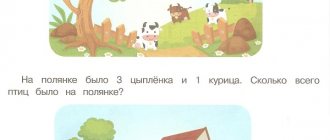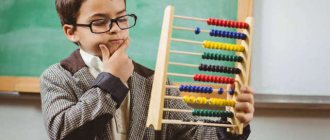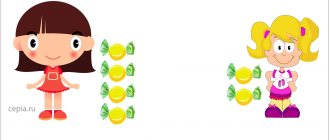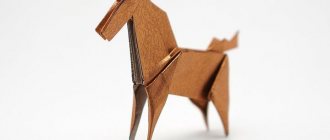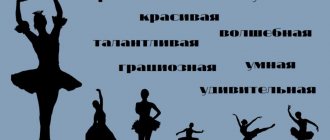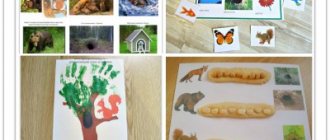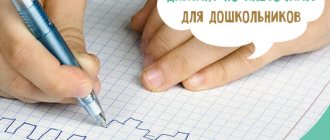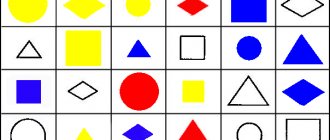Developing a child’s logical thinking is just as necessary as teaching new things, because knowledge is only tools, and logic is the ability to use them. Logic will teach you to analyze problems and situations, find and apply non-standard solutions. Such skills will be useful both in kindergarten and school, and in everyday life. There are many different exercises to develop logical thinking. But if your little one is tired of regular puzzles, offer him some fun math puzzles.
Logic puzzles for preschoolers 5-6 years old (for attentiveness, memory development)
10 interesting and exciting tasks for preschoolers. Source: www.liveinternet.ru
Task 1: Katya, Galya and Olya drew heroes from the village of Prostokvashino: Pechkin, Sharik and Matroskin. Who drew who, if Katya didn’t draw Pechkin and Sharik, and Galya didn’t draw Pechkin?
Task 2: There is a maple tree. There are two branches on the maple tree, on each branch there are two cherries. How many cherries are there in total?
Problem 3: If a goose stands on two legs, then it weighs 4 kg. How much will a goose weigh if it stands on one leg?
Problem 4: Two sisters have one brother each. How many children are in the family?
Problem 5: A giraffe, a crocodile and a hippopotamus lived in different houses. The giraffe did not live in a red or blue house. The crocodile did not live in a red or orange house. Guess which houses the animals lived in?
Problem 6: Once upon a time there were three girls: Tanya, Lena and Dasha. Tanya is taller than Lena, Lena is taller than Dasha. Which girl is the tallest and which is the shortest? What is the name of which one?
Problem 7: Misha has three carts of different colors: red, yellow and blue. Misha also has three toys: a tumbler, a pyramid and a spinning top. In the red cart he will not carry a spinning top or a pyramid. The yellow one is not a spinning top or a tumbler. What will Misha carry in each of the carts?
Problem 8: The dragonfly is not sitting on a flower or on a leaf. The grasshopper does not sit on a fungus or on a flower. The ladybug is not sitting on a leaf or on a fungus. Who is sitting on what? (It’s better to draw everything.)
Problem 9: Alyosha, Sasha and Misha live on different floors. Alyosha lives neither on the top floor nor on the bottom. Sasha lives neither on the middle floor nor on the bottom. On what floor does each boy live?
Problem 10: Three plates contain different fruits. The bananas are not in a blue or an orange plate. Oranges are not in a blue or pink plate. What plate are the plums in? What about bananas and oranges?
Learning numbers
First of all, the child needs to be taught to count to 10, and also to correlate the number of objects with the number.
These cards will help us with this. Cut the cards and say “This is number one” and one bee (or one apple, if you like these cards better). You can download all educational games at the end of the article.
Be sure to first recite the numbers with your child until he remembers the sequence. Count the objects with him and/or show the cards one by one.
Teach your child correctly, from 1 to 9 are numbers, 10 is already a number that is written in the form of numbers 1 and 0.
Logical problems in mathematics for ingenuity and ingenuity with answers
AWARENESS TASKS
- There were 9 steamships at sea. 2 ships docked at the pier. How many ships are there at sea? (9 ships.)
- There were 7 brothers walking, each brother had one sister. How many people walked? (8 people).
- What kind of dishes can you not eat anything from? (From empty.)
- The animal has 2 right legs, 2 left legs, 2 legs in front, 2 in back. How many legs does an animal have? (4 legs.)
- 9 sharks were swimming in the sea. They saw a school of fish and dived deep. How many sharks swam in the sea? (9 sharks, only they dived.)
- The vase contains 3 tulips and 7 daffodils. How many tulips are there in a vase? (There were 3 tulips in the vase.)
- 7 boys cleared one path in the garden. How many paths did the boys clear? (7 tracks.)
- 2 brothers each drew 2 drawings as a gift to their grandfather. How many drawings did grandfather receive? (4 pictures.)
- The grandmother knitted scarves and mittens for her grandchildren. In total she knitted 3 scarves and 6 mittens. How many grandchildren did your grandmother have? (3 grandchildren - explain the answer.)
- Grandfather, grandmother, granddaughter, Bug, cat and mouse pulled and pulled and finally pulled out the turnip. How many eyes saw the turnip? (12 eyes.)
Children collected an autumn bouquet in the park. It contained 5 maple, 4 birch, 2 oak, 1 aspen leaves. How many different trees did the bouquet come from? (From 4 trees.)
logicheskie_zadachi
Writing assignments 1st grade:
Writing assignments are very important for elementary school students. With the help of printed simulators, students learn letters, acquire writing and literacy skills. And thanks to beautifully designed assignments, learning is fun and interesting.
tick sticks: templates for children 6 7 years old
The proposed copybooks with different sticks, hooks and other elements of letters and numbers will help first-graders acquire calligraphic writing skills, and then develop beautiful and legible handwriting. And additional coloring drawings and tracings will make this process more fun.
read divide the words into syllables
One of the basic skills of a first grader is the ability to correctly divide words into syllables. To begin, offer your child cards with the rules for dividing words into syllables, and then consolidate the acquired knowledge using a simulator with tasks.
learning to hatch: templates for children 6 7 years old
To prepare your hand for writing, learn to think logically and analyze, offer your child the following patterns for shading.
Educational tasks for children “Find 10 differences”
Educational tasks for children “Find 10 differences”:
Educational tasks for children “Find 10 differences”
Educational tasks for children “Find 10 differences”
Educational tasks for children “Find 10 differences”
Educational tasks for children “Find 10 differences”
Educational tasks for children “Find 10 differences”
Educational tasks for children “Find 10 differences”
Educational tasks for children “Find 10 differences”
Educational tasks for children “Find 10 differences”
Educational tasks for children “Find 10 differences”
Educational tasks for children “Find 10 differences”
Educational tasks for children “Find 10 differences”
Educational tasks for children “Find 10 differences”
Educational tasks for children “Find 10 differences”
Educational tasks for children “Find 10 differences”
Educational tasks for children “Find 10 differences”
Educational tasks for children “Find 10 differences”
Developmental tasks for children “Compare and find differences”
Developmental tasks for children “Compare and find differences”:
Developmental tasks for children “Compare and find differences”
Developmental tasks for children “Compare and find differences”
Developmental tasks for children “Compare and find differences”
Developmental tasks for children “Compare and find differences”
Developmental tasks for children “Compare and find differences”
Developmental tasks for children “Compare and find differences” Developmental tasks for children “Compare and find differences”
Developmental tasks for children “Compare and find differences”
Developmental tasks for children “Compare and find differences”
Developmental tasks for children “Compare and find differences”
Developmental tasks for children “Compare and find differences”
Developmental tasks for children “Compare and find differences”
Developmental tasks for children “Compare and find differences”
Developmental tasks for children “Compare and find differences”
Developmental tasks for children “Compare and find differences”
Educational tasks for children “Find the difference” for coloring
Educational tasks for children “Find the difference” for coloring:
Educational tasks for children “Find the difference” for coloring
Educational tasks for children “Find the difference” for coloring Educational tasks for children “Find the difference” for coloring
Educational tasks for children “Find the difference” for coloring
Educational tasks for children “Find the difference” for coloring
Educational tasks for children “Find the difference” for coloring
Educational tasks for children “Find the difference” for coloring
Educational tasks for children “Find the difference” for coloring
Educational tasks for children “Find the difference” for coloring
Educational tasks for children “Find the difference” for coloring
Educational tasks for children “Find the difference” for coloring
Educational tasks for children “Find the difference” for coloring
Educational tasks for children “Find the difference” for coloring
Educational tasks for children “Find the difference” for coloring
Educational tasks for children “Find the difference” for coloring
Testing numeracy skills
When a child easily navigates numbers and correlates the number of objects and the corresponding number, the acquired skills can be consolidated.
Five-year-olds can be asked to find the neighbors of the numbers
For older children, you can make the game more difficult and offer number houses
Educational tasks for children “Find differences in pictures”
Educational tasks for children “Find differences in pictures”:
Educational tasks for children “Find differences in pictures”
Educational tasks for children “Find differences in pictures”
Developmental tasks for children “Find the differences in the pictures” Developmental tasks for children “Find the differences in the pictures”
Educational tasks for children “Find differences in pictures”
Educational tasks for children “Find differences in pictures”
Educational tasks for children “Find differences in pictures”
Educational tasks for children “Find differences in pictures”
Educational tasks for children “Find differences in pictures”
Educational tasks for children “Find differences in pictures”
Educational tasks for children “Find differences in pictures”
Educational tasks for children “Find differences in pictures”
Educational tasks for children “Find differences in pictures”
Educational tasks for children “Find differences in pictures”
Educational tasks for children “Find differences in pictures”
Educational tasks for children “Find the difference” - the best selection
Developmental tasks for children “Find the difference”:
Developmental tasks for children “Find the difference”
Developmental tasks for children “Find the difference”
Developmental tasks for children “Find the difference”
Developmental tasks for children “Find the difference”
Developmental tasks for children “Find the difference”
Developmental tasks for children “Find the difference”
Developmental tasks for children “Find the difference”
Developmental tasks for children “Find the difference”
Developmental tasks for children “Find the difference”
Developmental tasks for children “Find the difference”
Developmental tasks for children “Find the difference”
Developmental tasks for children “Find the difference”
Developmental tasks for children “Find the difference”
Developmental tasks for children “Find the difference”
Developmental tasks for children “Find the difference”
